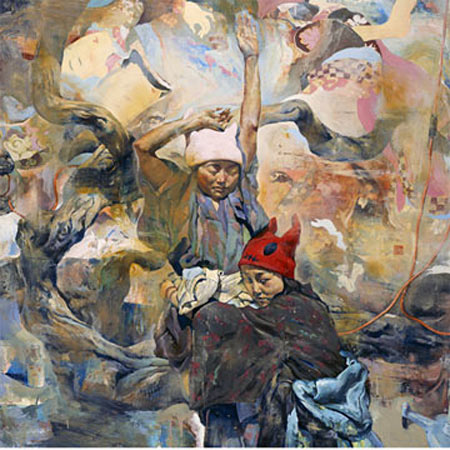
Joseph Campbell in “The Power of Myth,” writes that it is the function of the artist to act as interpreter of myth and humanity. It is a shamanistic role, aimed at transporting the viewer beyond the ordinary. Reconciling subjective realizations with uncertainty is one of the challenges of being human, and reflections on those challenges take center stage in the works of Kent Williams.
The connection between aesthetics and metaphysics is the crux of Williams’ emotionally charged paintings. His “Convergence” series combines narrative with symbolism so as to transport his subjects into the phenomenal world. Figures, represented by the artist or his friends, are set within a maelstrom of aggressive brushwork and a multitude of designs. A plethora of colors range from vivid and luminous to soft pastels. Subjects are either in mental states or dream states, the distinctions between the two not easily grasped. Often, they share space with dynamic whirls of patterns and colors, victims of external forces that make them appear dangerously close to being sucked into an impenetrable abyss. Mostly, subjects appear either resigned or overwhelmed, not only by their environments, but also by emotional dramas seemingly out of their control.
Symbolist undertones are resonant, particularly when the content has erotic connotations. In the psychically charged “Blond Natalia In Studio Arrangement” and “Studio Arran in Blue & Rose” for instance, nude figures are set within an artist’s studio, a sly reference to the artist as arbiter of emotional states. Whether connected to each other or standing apart, sexual tension is palpable. At the same time, they appear isolated by their own inner turmoil.
In “New Spring” a Japanese mother and daughter face a genuinely human drama. Represented in Japanese costume, they deal with the loss and separation that comes when a child has grown and has to separate. The pair are shown being swallowed by an external vortex, and as victims of forces that transcend culture. In “Tomorrow,” they become barely visible. Succumbing to a sea of change, their envelopment is almost complete.
Ultimately, it is the need for speculation that makes Williams’ works engrossing. In the mysterious “Convergence: Yumiko” the subject lies womb-like, engulfed in a sea of designs. A large alligator jawbone by her side offers a conundrum. What does it symbolize? Is she in a dream-state or merely contemplative?
Not all of Williams’ subjects struggle against either their known fate or with undefinable mysteries. It is their recognition, perhaps, of being poised on the brink between the two, and of the courage it takes to surrender to conflicting forces.
Although Williams’ figures seem to bravely pull the viewer into a sense of intimacy, they offer discomforting insights into human dilemmas. His paint forms layers of ambiguity and melodrama that offer the kind of provocation and unease that can also be distancing.
Published courtesy of ArtSceneCal ©2011
